
Tibetan Language & Its Evolution
Development throughout Time
Origin story
It all begins in the Middle Ages, more specifically in the seventh century, when the Tibetan Empire first emerged. The very first version of the language that came into existence during this ancient period of time has come to be known as “Old Tibetan.” For a century, it was archaic and not well-formed. But in the year of 816 AD, this all changed. Under the reign of emperor Sadnalegs, the language became officially standardized.
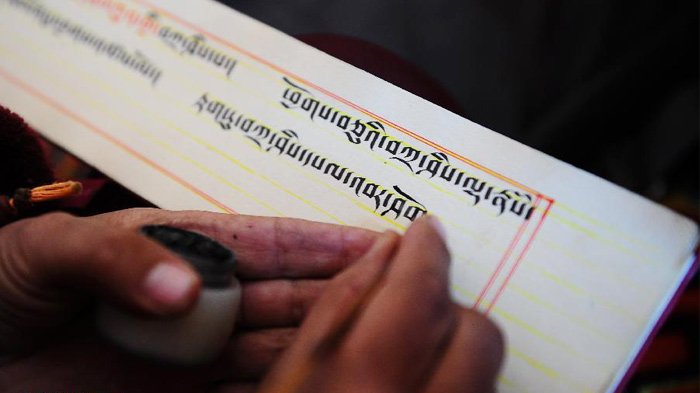 Learning Tibetan language
Learning Tibetan language
This process of transforming the Old Tibetan language into the systematized Classical Tibetan language began with the Indian language, which really lies at the foundation of the entire Tibetan language. Along with other canonical texts, Sanskrit texts were gathered in India by great leaders, like the famed Buddhists Yijing and Xuanzang. They would bring these texts with them back to Tibet where they would spend tireless days on end in chambers that were expressly devoted to the translating of scripts—the chambers found in the Jianfu Temple are a good example of this. After, they would work on the translations and ultimately develop a vocabulary and set of grammar rules that would become the Classical Tibetan language.
Classical Tibetan Language
While the phonology is not vastly different from Old Tibetan, the grammar is what really sets it apart from the discordant “style” of the past. Previously, in the days void of clear cut writing rules, authors would write in vastly different grammatical styles. This would make their works hard to read for anyone that happened to live outside of the author’s homeland, or for anyone brought up in a different period of time than that one in which he wrote—and by the way that’s all of us living today.
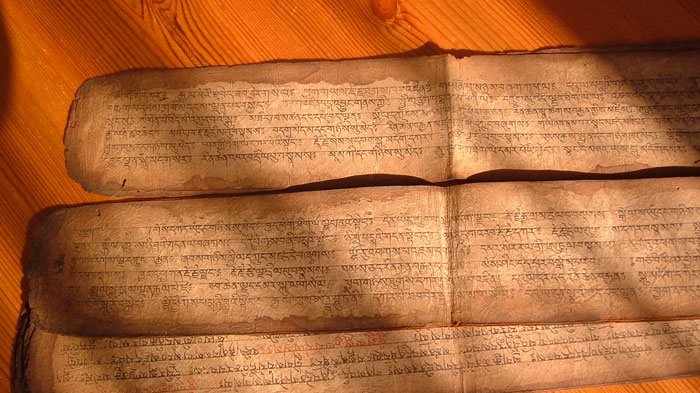 Classical Tibetan manuscript
Classical Tibetan manuscript
So when the Classical language emerged, with its standard vocabulary and grammatical rules set, it made texts much more readable, for people all over the world and for people living in all different time periods.
Contemporary Time
Out of Classical Tibetan evolved today’s version of the language; it is the most widely used, and for that it is called “Standard Tibetan.” This is based on the dialect in Central Tibet and in the region’s capital, Lhasa. It is considered a conservative language with orthography that recalls the ancient Old Tibetan phonology. It is written in an Indic script and uses high and low tones.
 Stone tablet with prayers in standard Tibetan language
Stone tablet with prayers in standard Tibetan language
Features of the language
Standard Tibetan language can be expressed in different ways, based on the type of discussion being had, or the social setting in which it is being used. In a formal setting, for instance, where proper grammar is generally expected, you will hear “zhe-sa” spoken, which is the polite, respectful speech most often employed in Lhasa. In a more laid back setting, on the other hand, you will hear the more colloquial “phal-skad”; this is the type of speech used in easy conversations amongst friends.
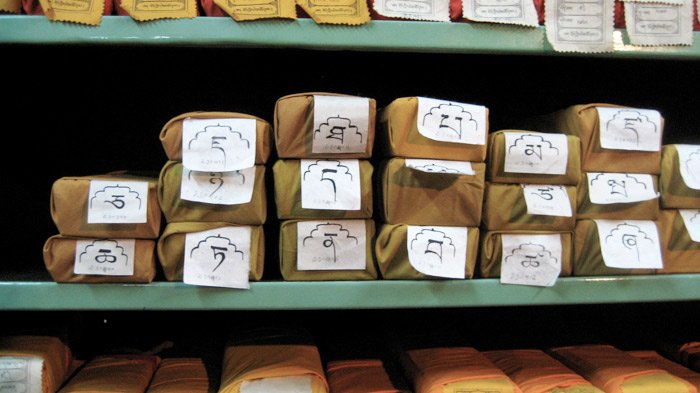 Pejas & scriptures of Tibetan Buddhism at a library
Pejas & scriptures of Tibetan Buddhism at a library
One notable distinction is the written form of the language: “chos-skad.” This is reserved for classical, literary works and scriptures. So, if you want to observe this while you’re in Tibet, make sure to visit religious spaces, like monasteries and temples, but also museums where ancient scriptures are displayed.
Various Branches of the Language by Region
You know how, when you spend so much with a person, you begin speaking more like them? The way you communicate becomes, over time, a mélange of your expressions and this person’s that you are constantly with? Well, it is through this type of mechanism that entire languages evolve. It’s why different parts of the world speak completely differently, but also why the “same” language can vary so greatly from region to region.
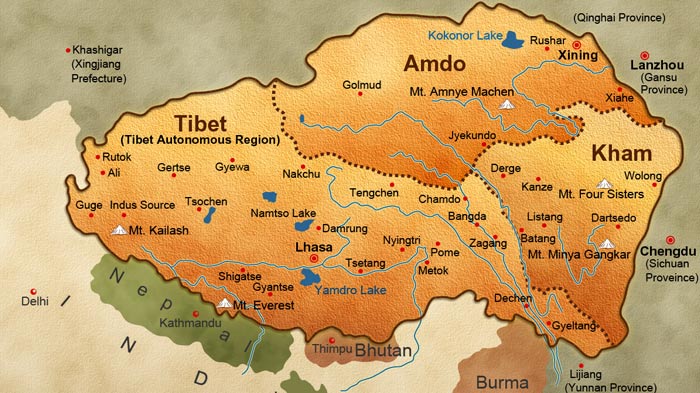 Tibetan language varies in different culture areas
Tibetan language varies in different culture areas
Tibet is no exception to this. While its different regions share the same written language, there is indeed diversity in the way people articulate their native tongue. You can hear this in the varied pronunciation, but, if you pay attention, you’ll even notice it in their syntax—aka their vocabulary choices and the way they each use unique grammar rules to form their sentences.
Central Tibetan
Central Tibetan is also known as Lhasa Tibetan, because it is renowned for being the branch of the language employed by the nation’s great capital. It is also distinguished as the most widely spoken form and for its being the basis of “Standard Tibetan.” But “Central Tibetan” may also refer to the dialects of other regions aside from Lhasa, including Nepalese territories like Mustang, Dolpo, and Walungchung Gola.
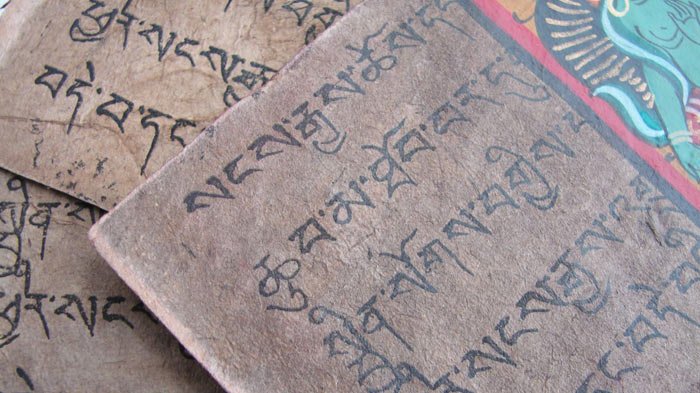 Paper fragment with old Tibetan writing
Paper fragment with old Tibetan writing
Khams Tibetan
As its name indicates, this is the branch of the Tibetan language that is found most commonly in the historical region of Kham. Can’t find Kham on your map? That’s because that’s actually the dated name for the land, what it used to be called. Today, with the administrative division of the People’s Republic of China, Kham encapsulates these four areas: Tibet Autonomous Region, western Sichuan province, southern Qinghai, and northwestern Yunnan.
 Tibetan language written on stones
Tibetan language written on stones
In addition to these regions, the language may be heard spoken by people in eastern Bhutan. The number of people to speak Khams there is estimated to be about one thousand people.
Amdo Tibetan
This branch is mostly spoken in the northwestern country Qinghai—also known as Kokonur, but may also be found in various parts of Sichuan and Gansu. Unlike the previously mentioned Khams and Central languages, Amdo Tibetan is not a tonal language. This means that it does not use tones to distinguish words. What it does have, is many consonant clusters, which means there are no vowels inserted between group of consonants to break them up. Within this branch there are various dialects including those of North, West and Southeast Kokonur, Labrang, Golok, Napa, and Kandze.
 Students learning a Tibetan language
Students learning a Tibetan language
Ladakhi Tibetan
Some people include Ladakhi in the four dominant branches of Tibetan language, while others leave it out, claiming it is more different and less utilized than the other three. But since we’ve now got your attention, let’s just get briefly into it.
Ladakh is most widely spoken in the Leh district of the Ladakh region, which is actually found in India and not Tibet—which may be another reason some discount this branch, for its prevalence being found mostly outside. It also stands apart from the others because it is a Tibetic language, rather than a classical Tibetan language, but this simply means it is spoken outside of Tibet and is not a reason to discount it. There are still approximately twelve thousand adherents to this branch in the Tibetan Autonomous Region, particularly in the northern plateau Changtang.
 Book named Manual of Standard Titeban
Book named Manual of Standard Titeban
There are some further divides, or dialects, within this branch. These include Ladakhi proper, Upper Ladakhi, Nubra, Shamskat, Stotskat, and the variety spoken in Zangskar.
Key Phrases for Travellers
So that you can get around a little bit better, we’ve gathered some basic Tibetan phrases that may be of service to you in your travels—it’s always nice to be able to, at least, say hello or thank you, right? Okay, here it is:
• Hello - tashi deleg
• Goodbye - kale shoo
• What is your name - Khye-rang-gi ming-la ka-re re?
• My name is - Nge ming-la / nga ming-la
• Nice to meet you - Khye ran jel-ne ga-po joong
• How are you? - Keh-rang ku-su de-bo yin-peh?
• I am fine - La yin. Ngah sug-po –de-bo-yin
• See you later - la song
• Yes - la-yo-re
• No - la-yo-ma-re
• Sorry - gonad
• Thank you - thoo jaychay
• You're welcome - kay-nang-gi-ma-ray
• I don't understand - ha ko ma song
• Do you speak English? - In-ji-ke shing-gi-yo-pe?
• How much? - Ka tso ay?
• I will take it - Nhi-geying
Before heading off…
You may notice that you’re a little unsure of how to pronounce some of these words/phrases. Are we right? Be sure to listen to some pronunciation videos, if this is the case; these will give you that auditory component that will help you out here. Good luck in your chats with the locals!
Will you be brave enough to strike up a conversation with the Tibetans?

With exceptional passion and outstanding leadership, Mrs. Catherine has dedicated herself to Tibet inbound tourism and China tour for 15 years. As one of the handful females who see great potential of Chinese inbound tourism, Catherine has made great contribution to promoting Tibet tourism and enhancing the employment of Tibetans and prosperity of local Tibetan community.
Over the years, she travelled overseas with Tibet Tourism Bureau many times to promote Tibet tourism. Currently, Catherine works as the marketing director of Tibet Vista, an opinion leader behind the whole team of Tibet Vista.


.jpg)




0 Comment ON "Tibetan Language & Its Evolution"